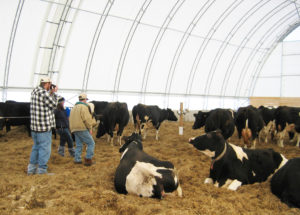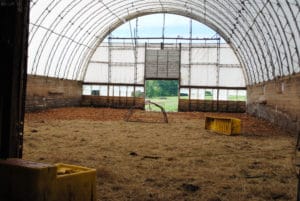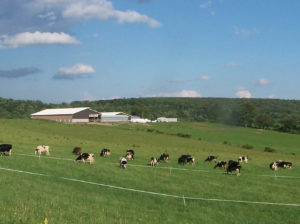Consider Deep Pack Barns for Cow Comfort and Manure Management

Cows relax as farmers tour a deep bedded pack barn in Vermont. Photo: A. Fay Benson
Small dairy farm operators may soon be confronted by the prohibition of winter spreading of manure. Any farmer looking to update their barns should consider a design that can accommodate a deep bedded pack (DBP) system.
A DBP system incorporates animal feeding and manure storage into one open barn, and can be especially helpful to smaller grazing farms. It generally consists of a foundation of concrete or hard clay. There may be a layer of gravel and then a bedding pack of straw, hay, sawdust or well-chipped wood shavings. Manure and urine mix into the bedding that remains in place for several months and is generally cleaned out once a year. A deep pack system is different than a composting pack that is aerated in the barn daily by tiller or turning. Biologic activity taking place 5-7 inches deep in the pack provides the heat that cows enjoy through the winter months.
Pros of a Deep Bedded Pack System
- Comfortable environment reduces lameness and provides for deep and restful sleep that in turn positively impacts milk production.
- Manure storage with less capital investment and less labor requirement than liquid storage
- Pack manure mixed with extra carbon is a better soil nutrient then raw manure from typical manure storage.
- Particularly adapted to grazing dairies since barns are used only 6 months and allow plenty of time to clean
- An option for out-dated dairies looking for build a combined housing-feeding barn with manure storage
Vermont Pack Barns Show Results
Deep bedded pack barns have been used in Vermont since the state prohibited winter spreading of manure in 1995. During a visit to Jack Lazor’s organic Butterworks Farm in Westfield, VT, in January, I observed the pack’s effects on cow comfort. The pack at Jack Lazor’s registered a cozy 80 degrees F.
The bedding pack rises over time as more and more bedding is added throughout the winter. If watering systems are used on the pack to accommodate multiple groups, they need to accommodate this rise by placing a coil of water line underneath the waterer. As the pack rises, the waterer is lifted up. If there is only one group of animals or if all animals can get to the feed alley, then the waterers should go there.
This past summer I visited Jack’s farm again. The 350-acre farm was established in 1979 making door-to-door deliveries of its own yogurt and cottage cheese. Today the farm includes its own granary, yogurt and cheesemaking with product distribution throughout Vermont and New Hampshire.

Jack Lazor’s deep pack barn clean out for summer. The waterers have approximately six inches of line underneath so the waterers rise as the pack rises with more bedding applications. Photo: A. Fay Benson
The third-generation farm milks a herd of 85 Jerseys on an 80-percent forage diet. From November to May the cows are housed in a 60-foot-wide, 120-foot-long, hoop-top barn. Straw is added for clean bedding twice a day. Approximately a bale and a half is used per day.
I arrived for my second visit to the farm in August, just as the compost piles were being aerated with a tractor-powered turner. The pack is moved from the barn in June after crop work is completed and the first cutting of hay is harvested. Jack uses a dump truck to move the manure from the barn to long rows in a field for composting.
He does not go through the required process to produce Certified Organic Compost. He is mainly interested that the manure becomes “aged” so that it has stabilized most of the nutrients and is easier to spread in the fall. Jack explained his reasoning for this timing with a question. “When does nature apply its carbon and nutrients to the soil?” Carbon and nutrients (like dead grass, leaves and decaying roots) are applied in the fall and decompose through the winter so they can be used in the spring for new growth.
I asked Jack about the significant expense of the straw for the pack: $80 every other day plus the labor of composting the pack. Jack said that the return is in the positive effect on the soil and soil nutrients. (Since my visit, Jack has started harvesting his own straw, reducing his expense)
“Raw manure is hard on the soil and the environment. Many of the nutrients are volatile or water soluble. When straw, which has a high ratio of carbon, is added, more of the volatile nutrients are captured and stored”, Jack explains. These stored nutrients undergo the biological activity of composting which stabilizes them and minimizes run-off in a heavy rain.
Keep in Mind
- As with any type of housing structure, adequate bedding and good milking hygiene help manage the pathogens naturally found in a bedded pack system.
- Side retaining walls need to be strong enough to contain 4-6 feet of the pack and stand up to cleaning. Cow access, animal grouping, and travel-to-the-feed-alley patterns can be managed by electric fences which reduce manure in bedded areas.
- Good ventilation – whether the barn is positioned to take advantage of geography for natural wind ventilation or uses mechanical assistance with fans – helps keep the cows healthy, the pack dry, and odors down.
- Opinions differ on just how much room should be allowed per cow, but it is generally advised to allow for 70-85 to 100 sq. ft. per animal which is higher than freestall style housing. Breed, age, and animal condition impact that decision-making when planning a new barn. The general consensus is the more room the better, making a DBP system better suited to smaller herds.
New York Farm Adds Pack Barn in 2010
In 2010, Ben and Kate Whittemore of Dead End Farm in Candor, NY, built a 70×250-foot bedded pack barn with a 16-foot feed alley and 16-foot scrape alley. The Whittemores operate an 80-cow organic dairy, raise grass-fed beef cattle and pigs, and have a free range flock of laying hens. They sell products from the farm by appointment and at area farmers’ markets. They were recognized as Super Milk producers in 2010.

Ben and Kate Whittemore’s organic dairy herd grazes with Dead End Farm’s new deep bedded pack barn in the background. Photo by Kate Whittemore
“Our cows love the bedded pack barn with its thick cushy bedding and wide open space to kick up their heels,” Kate Whittemore writes in her farm blog. “Most of our cows will choose the bedded pack at night over the pasture.”
While using chopped hay in the pack was less expensive, it was more labor intensive and not as dry, and “since hay is in short supply this year, we plan to use a layer of bark and kiln-dried sawdust this winter,” Kate says.
Kate and Ben built the new barn with cow comfort and health as their primary concerns. They were also interested in the soil health benefit of the aged manure compared to slurry. “We are waiting on results of a comparison of nutrients between the two, but I have to think the additional organic matter in the bedded pack adds value to our fields,” she says.
Check on Funding Assistance
Because of the environmental benefits of a bedded pack system, the USDA Natural Resources Conservation Service (NRCS) may offer funding incentives for designs that pass their engineering specifications. Contact your local NRCS office to learn more.
Resources for more Information
Resources for more Information
- Bedded Pack Management System Case Study by John M. Thurgood, Paula C. Bagley, Challey M. Comer, Daniel J. Flaherty, Jason Karszes, Mariane Kiraly, Cornell University Department of Applied Economics and Life Sciences, September 2009
- Conservation and Producer Benefits of a Bedded Pack Management System by John M. Thurgood, Cornell Cooperative Extension, and Brian K. LaTourette, Watershed Agricultural Council, 2007
- NRCS Fact Sheet: Compost Bedded Pack Dairy Barns, June 2007
- Video: Milking Time at Dead End Farm, Candor, N


Deep pack housing sounds good, but would like to learn more . I have only 30 head of beef cattle , and would like to see if you think it is feasible for me to even consider. I want my cows to be as comfortable as possible in the winter when not on pasture. What are farmers using to make up all this bedding? And what effect it has on the land? I only have pastures and hay fields , no tillable land.I would like any ideas or suggestions you may have.
Thank You
Richard Wright